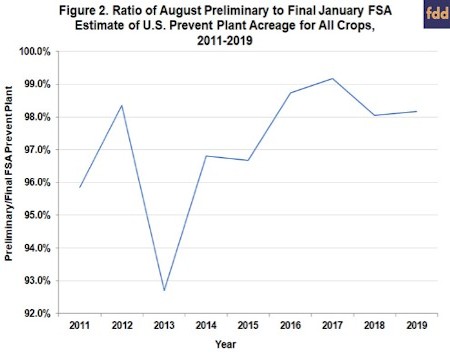By Scott Irwin and Todd Hubbs
Department of Agricultural and Consumer Economics
University of Illinois
Prevented plant coverage under the Federal crop insurance program provides payments when farmers are unable to plant within a normal time window (e.g., farmdoc daily, May 14, 2019). Estimating the number of prevented plant acres in a year can be important part of projecting total principal crop acreage in the U.S. and the potential crop size of individual crops, such as corn and soybeans. Figure 1 demonstrates how prevented plant acreage contributes to understanding the variation in total crop acreage in recent years. For example, prevented plantings in 2019 were record high and totaled 19.6 million acres, or 5.7 percent of the estimated total acreage base. For several years, the Farm Service Agency (FSA) of the USDA has published preliminary data on prevented plant acres in August through December. The purpose of this article is to estimate the relationship between the preliminary and final prevented plant acreage and to use this relationship to predict final prevented plant acreage for corn, soybeans, and all crops in 2020.

Analysis
FSA policy requires that producers participating in several Federal commodity programs submit an annual report regarding all cropland use on their farms, including prevented plant acreage (farmdoc daily, January 27, 2016). The deadline for reporting acreage each year is July 15th for most crops. In consideration of the COVID-19 pandemic, the FSA waived the late fee for 30 days this summer, which raises the possibility that the normal pattern of reporting to FSA will not hold in 2020. The FSA issues monthly reports of planted acreage to the public beginning in August based on farmer reports received and summarized to date. The final report is released in January and, in theory, that data represent a complete census of acreage enrolled in the farm programs administered by the FSA, including prevented plant acreage.
We begin by reviewing the relationship between the preliminary and final prevented planting acreage estimates for corn, soybeans, and all crops from 2011 through 2019. The time period is selected based on the availability of FSA data at the FSA website. As shown in Table 1, all but a very small slice of prevented plant acreage for corn, soybeans, and all crops is reported in August. For example, over 2011-2019 the average ratio of preliminary to final prevented plant acreage for corn, soybeans, and all crops is 97.4, 98.3, and 97.7 percent, respectively. The average ratios all move above 99 percent in September and reporting is virtually complete by October. Note that some preliminary observations are above 100 percent due to subsequent downward revisions in the data.

There is some variation in the relationship between preliminary and final prevented plant acreage that is obscured by the averages over 2011-2019 in Table 1. As an example, Figure 2 presents the yearly ratios for corn in August. Two things stand out. First, there was a sharp drop in reporting in 2013. Second, there is overall an upward trend in reporting for August over time. These same trends are found in soybeans and all crops. Consequently, we also present statistics for the ratio of preliminary and final prevented planting in Table 2 only for the last four years, 2016-2019. This increases the average ratio for corn, soybeans, and all crops in August to 98.5, 99.0, and 98.7 percent, respectively.

We can now apply the relationships between preliminary and final prevented plant acreage to the August 2020 report issued by the FSA to estimate final prevented plant acreage. The computations are as follows:

Given the assumed ratios, the estimated increase in prevented plant acreage from the August preliminary report to the final are not very large, about 80,000 acres for corn, 12,000 acres for soybeans, and 122,000 acres for all crops. However, as noted earlier, the July 15th reporting deadline was effectively waived for 30 days this year due to the COVID-19 pandemic. This may delay reporting compared to the pattern of recent years. To provide some perspective, we redo the computations but assume the lowest reporting ratio for all crops, 94.5 percent that occurred in August 2013. At this reporting level for August 2020, we estimate final total prevented plant acreage for all crops would be 520,000 acres higher than the preliminary August estimate.
Implications
Prevented plant acreage can be an important consideration when estimating U.S. planted acreage for corn, soybeans, and all crops. The Farm Service Agency (FSA) of the USDA issues preliminary estimates of prevented plant acreage on a monthly basis from August through December. Final figures are released in January. We estimate the relationship between the preliminary and final estimates and find that all but a very small slice of prevented plant acreage for corn, soybeans, and all crops is reported in August. For example, over 2011-2019 the average ratio of preliminary to final prevented plant acreage for corn, soybeans, and all crops is 97.4, 98.3, and 97.7 percent, respectively. The normal historical relationships suggest minimal increase in the preliminary August prevent plant acreage for 2020 released earlier this month. However, some reporting delays are likely due to the COVID-19 pandemic and this could result in larger than normal increases in prevented plant estimates as additional monthly reports are released.
Source : illinois.edu